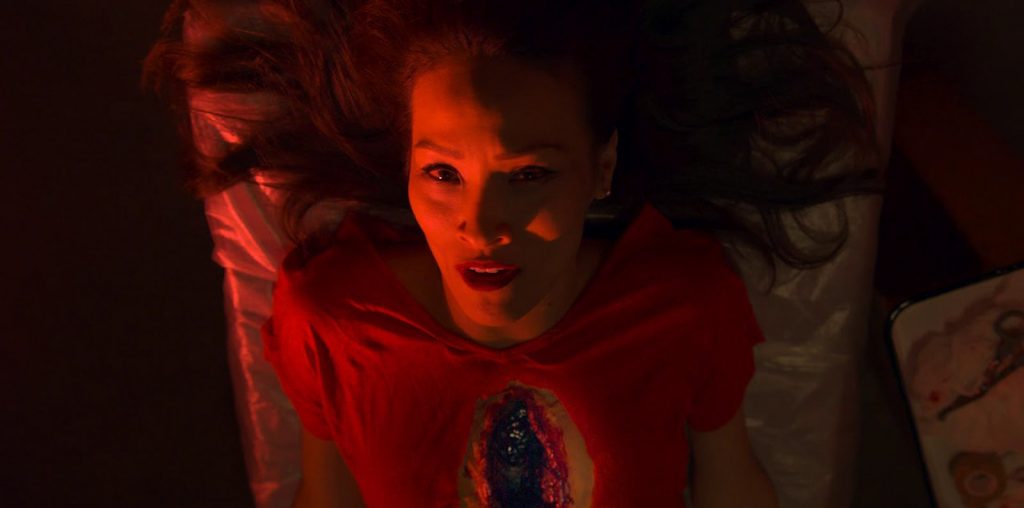
“Cavite” is Ian Gamazon (writer, director, actor) and Neill Dela Llanna’s (writer, director) fourth film; the previous three features have had spotty festival luck and little interest from audiences and distributors alike. According to his production notes, Ian Gamazon feels that “persistence doesn’t necessarily pay off”. I disagree. “Cavite” is proof that, despite horrendous budget constraints, a good filmmaker with a great idea and lots of practice can make a damn fine (and original) film. “Cavite” is more than just an “expensive home movie” (as the self-defeating Gamazon puts it); it’s a remarkable film that is interesting and appropriately contemporary in style as well as subject. The psychological anxiety that “Phone Booth” tried (but failed) to install in its audience via the unseen voice has been achieved in Gamazon and Llanna’s film. “Cavite”, minus the veteran director, huge budget, enormous crew and Colin Farrell, did what Phone Booth couldn’t. The film, however, isn’t just a disturbing thriller; it is a well-developed, multi-layered feature that doesn’t fit easily into a precise genre.
The beginning of the film is not an indication of where it is headed. My first thought was, here we go again, another slow placed, relationship driven movie inspired by Lost In Translation. About 15 minutes into the film I realized my initial impression was totally off base. “Cavite” opens with a short, but significant conversation between Adam and his girlfriend regarding an unplanned pregnancy. The introductory scene is followed by a series of shots of Adam’s mundane life, mainly focusing on his job as a security guard. He soon leaves for the Philippines to attend his father’s funeral (though this motivator is a bit vague). Upon his arrival at the Philippine airport things take a quick turn, pacing included. Adam receives a rather disturbing phone call concerning the fact that his mother and young sister have been kidnapped by (as is later revealed) the Abu Sayyaf, a notorious Muslim terrorist group who are at war with the Philippine government for control of the southern part of the country. Adam is forced to obey the caller in order to spare his remaining family members from torture and eventual death.
The kidnapper’s performance is extremely impressive, it helps that the lines are so well written, but the terrorist caller manages to deliver an impressively creepy and believable performance despite the fact that you never see him and his lines are subtitled. Unlike “Phone Booth”, the script and actors don’t overdo it and come off heavy-handed, instead the approach is right on target. The explicit demands of the caller are what drive the film. Adam is forced to interact in a society that he was born of, but is estranged from. He is forced to travel through foul smelling areas of extreme poverty, eat a nasty egg that “shows the actual form of the baby egg in a fetal position” (apparently a delicacy in the Philippines), and witness a cockfight, in addition to other things that most people wouldn’t want to spend their afternoon attending to. The Muslim terrorist caller displays a true disgust for anyone who isn’t directly aligned with his beliefs (as well as a rather strange homophobic attitude that is almost obsessive) and seems to thoroughly enjoy torturing the Americanized Adam. Eventually, the caller’s real intentions are revealed and Adam is faced with an atrocious dilemma that most wouldn’t wish upon their worst enemy. Several elements to the film’s plot are unclear, such as the exact reason for the separation of Adam’s family, or his dead father’s role in the turn of events. Ultimately, however, it doesn’t matter, the plot is strong enough that the shady details seem insignificant.
Ian Gamazon’s performance is impressive on its own, but it’s even more striking considering he was forced to play the role (originally written for an Asian female, preferably Filipina) because no one fitting the bill in Los Angeles was willing to live in a small hotel room with two strangers in the slums of the Philippines and eat an unfertilized egg for very little money. Over the past ten years too many movies have used their minimal budget as a flippant excuse to go handheld, but in the case of “Cavite” the choice is not only budgetary, but a stylistic one, it is entirely motivated and works perfectly with the story and environment.
One thing that I learned from “Cavite”, is that my next vacation will not include a visit to the Philippines. The movie’s landscape is dismal and upsetting (yet the film is visually stunning). It shows a kind of poverty and desperation that most Americans rarely see. “Cavite” captures a world that Hollywood films like “Beyond Borders” try to depict, but aren’t willing to get their hands dirty (or put their actors in harm’s way) in order to achieve. Within the devasted setting of the Philippine ghetto is the occasional and immediately recognizable McDonalds or 7-11. The American chains stick out against the foreign backdrop and create an aesthetic amalgamation that is breathtaking. The shots that focus on the presence of McDonald’s work perfectly to display the conflicted identity (religious and cultural) of the Philippine-American main character. The scenes display a stunning contrast to images from Morgan Spurlock’s Super Size Me.
“Cavite” is a thoughtful and skillfully developed story and a true Independent film. If you have a chance to see it, do.
